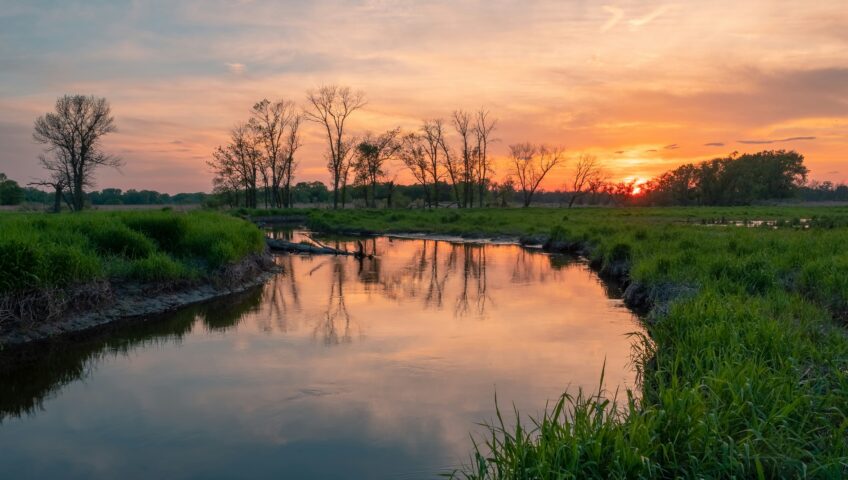Wetlands function as natural water filters, shelters for wildlife, and shields from floods for local communities. Canada’s Lower Mainland is home to iconic wetlands such as Burns Bog and the Fraser River Estuary, but wetlands in the region have dwindled because of the adverse impacts of urbanization and agriculture. Today, the Lower Mainland has lost over 85% of its wetlands. But what are the effects of wetlands restoration?
Wetlands guard communities from flooding, create biodiversity hotspots and reverse the impact of climate change. They also bolster local economies and preserve cultural heritage. Their contributions to nature and the communities in the Lower Mainland are critical, but their numbers are dropping rapidly. Only wetland restoration ensures that the Lower Mainland does not lose its precious ecosystems.
To help you understand the value of wetlands better, we will highlight 5 critical reasons why wetland restoration is essential for the Lower Mainland. We’ll discover how revived wetlands preserve valuable ecosystems and overturn the adverse effects of climate change.
Wetlands Safeguard Communities
The Lower Mainland is always at risk of seasonal flooding due to its geological position. Its coastal shores and mountainous terrain create varying climate conditions that evolve rapidly. Wetlands take on the role of natural buffers as they absorb excess rainwater and lessen the pressure on storm drains. For example, Burns Bog contains sphagnum moss, which can hold about 30 times its weight in water.
Here are 3 ways wetlands preserve communities in the Lower Mainland:
- Flood Protection: Wetlands slow the runoff generated from rainfall and lower flood peaks in rivers like the Fraser. Burns Bog saves Richmond and Delta from seasonal flooding this way.
- Cost Savings: According to research data, every dollar that’s invested into wetland restoration and natural habitat generates $22 worth of economic benefits for the communities.
- Groundwater Recharge: The sediment layers in wetlands act as a filter. They cleanse the water and pass it into aquifers, securing clean water for local communities.
By the year 2100, ocean levels will see a 1-meter rise. It may seem inconsequential, but it will cause a higher number of storm surges and augment their intensity. Wetlands will be the natural and most powerful defence in such a scenario.
Wetland Restoration Revieves Biodiversity Hotspots
The Lower Mainland houses a significant number of Canada’s endangered species, many of which are completely reliant on wetlands for survival. For example, the salmon nurseries of the Pitt River marshes and the migratory bird stops in Boundary Bay are dependent on these wetlands. Species like the Oregon spotted frog and great blue heron rebound are also dependent on wetlands to continue their life cycle.
There are 3 ways wetlands help endangered and native species:
- Pollination Support: Wetlands are hosts to a variety of flowering plants. The moist habitat helps support bees, butterflies and other pollinators, who in turn help local farms through crop pollination.
- Fish Habitats: Wetlands are essential for many stages of the salmon’s life cycle. They play a vital role in rearing and migration habitats for the species. The soil conditions, water quality, temperature and flow provide the ideal breeding and rearing conditions for many other species of fish.
- Invasion Control: Wetlands provide perfect soil conditions for plant species to grow. Native plant species such as Red‑osier Dogwood (Cornus sericea), Sitka Willow (Salix sitchensis), Hardhack (Spiraea douglasii), and Native Sedges (Carex obnupta) can take root in wet, nutrient-rich soils and outgrow invasive species quickly.
Through wetland restorations, we restore the homes of these species and protect the region’s ecological identity. We help preserve the natural functions and biodiversity that define the Lower Mainland. Since the Lower Mainland’s land is pressured by urbanization efforts, restoring wetlands helps us fight to keep the ecological character and integrity of the area.
Wetlands Fight Climate Change
Wetlands are carbon powerhouses. Peatlands in particular store up to 10 times more carbon per unit area than forests can. Wetlands fight the ambient temperature increase caused by climate change through natural evaporation. Also, they aid greatly in retaining moisture and preventing drought.
Let’s look at 3 ways wetlands reduce carbon emissions and fight climate change:
- Carbon Sequestration: Wetlands such as Burns Bog can store up to 640,000 tonnes of CO2 per year. By locking away greenhouse gases, wetlands in the Lower Mainland offset a significant amount of carbon emissions.
- Ambient Heat Reduction: Research has shown that wetlands reduce ambient temperature through evaporation and moisture retention. For cities such as Langley and Abbotsford, wetlands have a noticeable impact on fighting the temperature rise caused by climate change.
- Drought Prevention: Healthy wetlands function as natural reservoirs. The soil and the plants reserve moisture, slowly releasing water during dry periods, which helps maintain local hydrology and provides drought mitigation benefits.
Wetlands have a powerful impact on fighting climate change. According to CleanBC Roadmap 2030, wetlands contribute more to offsetting the effects of climate change than any engineered efforts. So, restoring and maintaining wetlands is crucial for the Lower Mainland.
Wetlands Preserve Heritage
For many indigenous communities in the Lower Mainland, such as the Musqueam and Tsleil-Waututh, wetlands are sacred spaces tied to traditions and food systems. Restoring sites like the Serpentine Fen honours these connections while reviving medicinal plants and ancestral fishing grounds.
Here are 3 ways restoring wetlands preserves their heritage:
- Food security: Wetlands are a source of traditional foods, like camas bulbs. Many communities fish salmon, and harvest plants from wetlands.
- Education: Wetlands that are frequented by the indigenous communities stand as symbols of their history, culture, and beliefs. They can use these lands to educate their new generations, and others about their heritage.
- Healing spaces: Wetlands offer mental health benefits through nature therapy, and provide spaces for cultural activity.
These communities have longstanding cultural and spiritual connections to wetlands. For many, it’s their food source, their place of peace, and their connection to nature.
New Wave Earthworks. Wetlands Restoration Experts in the Lower Mainland.
Wetlands restoration is a complicated process that requires proper knowledge, dedication, and patience. New Wave Earthworks has extensive experience in large-scale wetland restoration projects, aimed at reviving these crucial ecosystems. We conduct careful planting of various species specific to each project, and our crew is adept at the removal of invasive species, ensuring the long-term health of these restored areas.
So, if you are looking for environmental construction experts in the Lower Mainland, especially Chilliwack, Abbotsford, and the Tri-Cities, New Wave Earthworks is your best solution. Call us today at (604) 855-2603!
Conclusion
It is estimated that the Lower Mainland has lost over 70% of its wetlands over the last two decades. At this point, restoring them has become a priority. Wetlands are ecosystem lifelines that we cannot afford to lose. We should focus on restoring the wetlands so that we can safeguard the Lower Mainland’s future.


